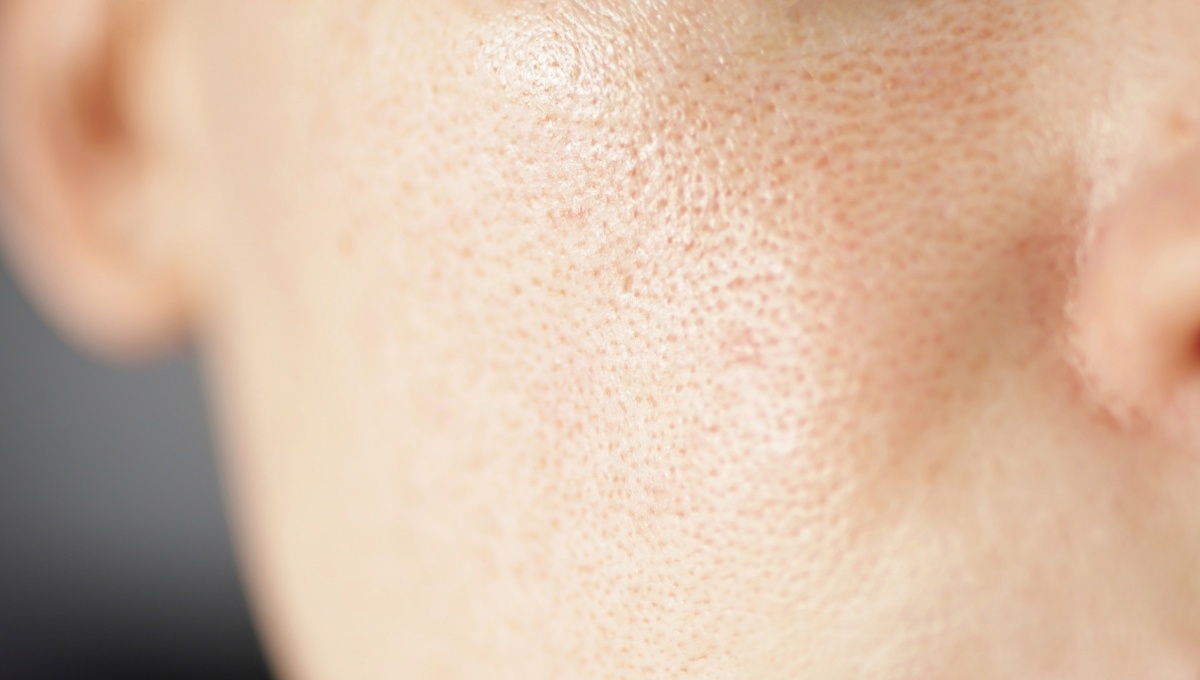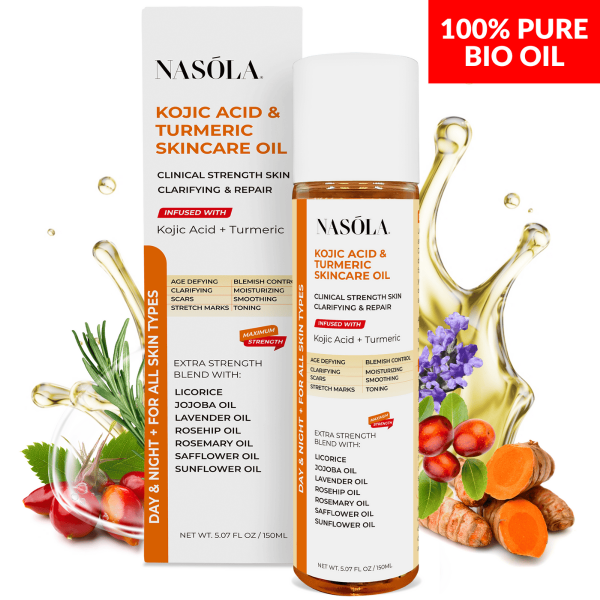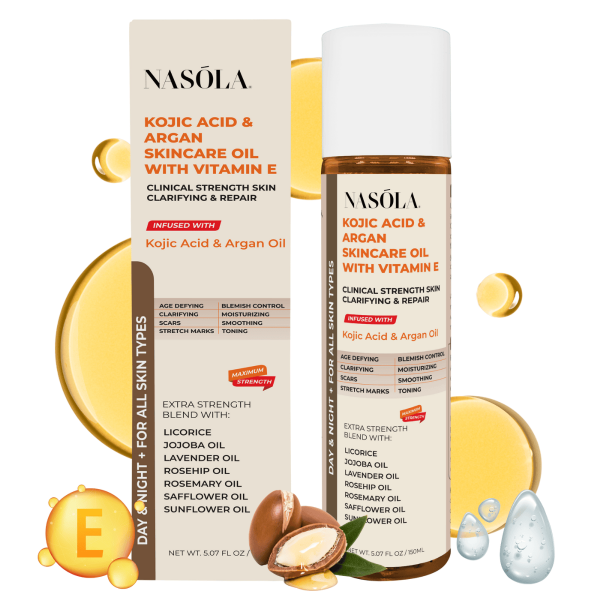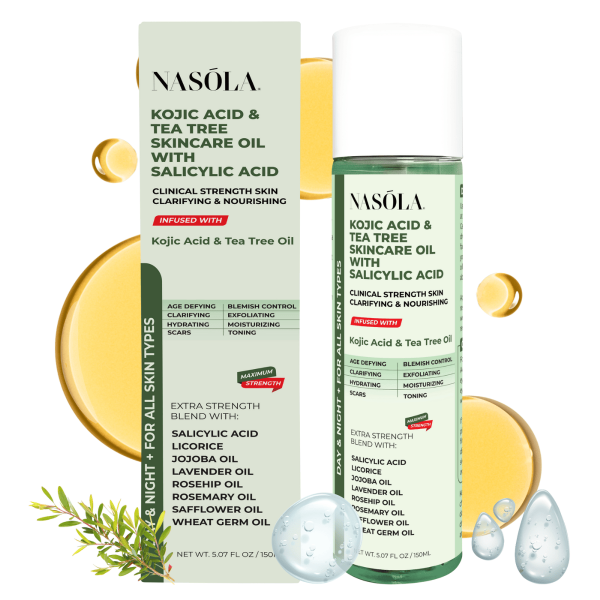Let’s get right into it—does Bio Oil clog pores? If your skin has ever turned on you after trying an oil, we get it.
That feeling when you’re doing everything “right” but still wake up with new breakouts??
Been there. It’s not just frustrating—it makes you question EVERYTHING you’ve applied to your face. Especially when it’s something marketed as a skin savior.
With oil-based skincare on the rise, especially from brands offering advanced formulas (hello, Nasola 👋), many of us are doing double-takes and asking smarter questions.
Are these Bio Oils safe for acne-prone skin? What about dry, sensitive, or combo skin? Can I finally fade those dark spots without breaking out in the process??
In today’s post, we’ll unravel all of this.
And YES—we’ll talk about lightweight, non-comedogenic oils infused with turmeric, tea tree, kojic acid, and more wellness-packed ingredients found in Nasola’s signature Bio Oils.
By the end, you’ll know exactly what’s going on your skin and why it matters.
- Does Bio Oil Clog Pores: Breaking Down the Comedogenic Concern
- Skin Types and Bio Oils: Is It Right for You?
- Ingredient Spotlight: Why Kojic Acid Matters in Bio Oils
- The Role of Argan Oil in Preventing Pore Clogging
- Why the Base Formula Matters More Than the Term "Bio Oil"
- How to Choose the Best Bio Oil for Your Skin Concerns
- Conclusion
- Frequently Asked Questions (FAQs)
Does Bio Oil Clog Pores: Breaking Down the Comedogenic Concern
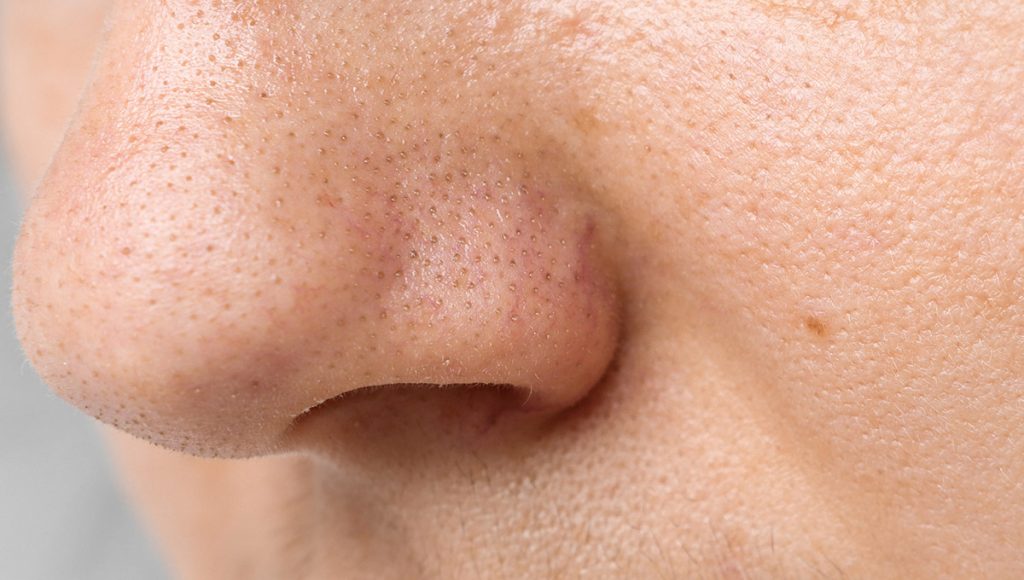
Worrying whether Bio Oil clogs pores isn’t just a skincare drama episode—it’s a legitimate concern, especially if your skin tends to act out when things get too rich.
Comedogenicity, that not-so-glamorous word, basically tells us how likely an ingredient is to clog a pore—and every breakout-prone girlie or guy should care about it.
But here’s something you might NOT know: not all oils are created equal. Some oils are lightweight, fast-absorbing, and magical (looking at you, jojoba and argan).
Others?
Not so much. It all comes down to the combination of ingredients, skin type, and how those ingredients behave on your face.
Let’s dissect some truth, shall we?
What “Clogging Pores” Really Means
When skincare ingredients are referred to as “comedogenic,” it means they’re likely to block pores and contribute to comedones—those lovely things we call blackheads and whiteheads.
But hold up… pore-clogging isn’t universal. The same formula can behave differently on oily vs. dry skin.
Comedogenic ratings run from 0 (not likely to clog) to 5 (basically, run!).
And oils vary dramatically on this scale. Cocoa butter? High. Argan? Low. And crucially—it’s not just an oil’s presence, but how it interacts with everything else in a formula that matters.
Keep an eye out for the following:
- Oils WITH added synthetic fragrances (a red flag for sensitive skin)
- Heavy emollients layered under occlusives
- Oils with high comedogenic ratings (like coconut oil, sadly 🥲 for face use)
- Formulas with zero exfoliating or anti-inflammatory support
Now, onto the juicy part—modern blends vs old-school Bio Oil.
Bio Oil’s Original Formula vs. Modern Alternatives
The OG Bio Oil? Loved by many, feared by some.
Originally designed to improve the appearance of scars, stretch marks, and uneven skin tone, the formula contains mineral oil—a fairly common skin softener—but one that ranks high in the comedogenic conversation.
So yeah… if you’ve got oily or acne-prone skin, that formula might’ve led to trouble.
Modern skincare saviors like the Nasola Kojic Acid Turmeric Skincare Bio Oil are pushing the narrative forward. This genius infusion combines:
- Non-comedogenic, lightweight organic oils
- Brightening turmeric (goodbye, dull skin!)
- Kojic acid to tackle dark spots
- Anti-inflammatory benefits from turmeric
Bottom line?
All oils are not villains.
Nasola swaps out heavy mineral oils for natural, fast-absorbing carriers designed to nourish without turning your pores into potholes.
Skin Types and Bio Oils: Is It Right for You?

Before you panic about oil on already oily skin or chalk up dry patches as unsolvable—let’s take a breather.
Matching your Bio Oil to your skin type is everything. What works wonders for one person might wreak havoc on another.
Let’s decode that relationship.
Oily and Acne-Prone Skin
Now… for everyone who has googled, “Can I use oil if I already have oily skin?”—I hear you. The idea of putting MORE oil onto a shiny face feels like skincare insanity. But plot twist—using the right oils can help balance your sebum production.
Especially Bio Oils enriched with salicylic acid and tea tree oil. Like Nasola’s Kojic Acid Tea Tree Skincare Bio Oil with Salicylic Acid. It’s a multitasking masterpiece ✨
Here’s why it’s perfect for acne-prone skin:
- Salicylic acid exfoliates deep inside the pores
- Tea tree oil calms inflammation (that angry-red kind 😡)
- Kojic acid fades post-acne marks
- Lightweight formula won’t stifle your pores
This isn’t a “hope-for-the-best” solution—it’s a routine-balancing support product that treats breakouts while preventing new ones. BLESS.
Dry and Sensitive Skin
Now to my sensitive angels 🧖🏾♀️… If your skin flakes if you even look at a new product, gentleness is your ride or die. Dry and sensitive skin types need hydration, barrier support, and zero clogging nonsense.
That’s where Nasola Kojic Acid Turmeric Bio Oil swoops in like the hero it is.
Key perks for fragile, parched skin:
- Turmeric reduces redness and irritation
- Brightening without sensitizing your skin barrier
- Deep hydration without a heavy residue
- A zero-fragrance option that respects your skin’s boundaries 🙌
Let’s normalize oils that heal instead of harm.
Ingredient Spotlight: Why Kojic Acid Matters in Bio Oils

Now let’s talk about the MVP—Kojic Acid.
It’s like the fairy godmother of brightening ingredients… but without the poison apple vibes. If you’re waging war against hyperpigmentation, dark spots, or dullness, this ingredient is non-negotiable.
And TRUST—it won’t leave you greasy. Especially when paired with anti-inflammatory oils.
Brightens Without Blockage
Kojic acid works by inhibiting tyrosinase, an enzyme involved in melanin production—meaning it gradually fades discoloration, post-acne scars, and dark spots. Best part? It does so without clogging pores.
The Nasola Kojic Acid Argan Skincare Bio Oil is one of the most effective brightening oils without heaviness. Here’s how it contributes:
- Kojic acid targets stubborn pigment spots
- Argan oil supports skin repair and regeneration
- Lightweight, non-occlusive formula
- Doubles as a hydrating layer for dry or maturing skin
If you’re tired of creams that sit on top or fade by noon—this blend goes deeper and lasts longer.
Pairing Kojic Acid with Anti-Inflammatories
This combo?? Too good. Kojic acid on its own is powerful, but when fused with turmeric or tea tree oil, you get:
- Spot-fading + anti-bacterial benefits
- Brightness without the burn
- Redness reduction with pigment targeting
- Improved tone and texture in a shorter time
Kojic acid doesn’t aggravate acne—it improves what’s left behind. TAG TEAM.
The Role of Argan Oil in Preventing Pore Clogging
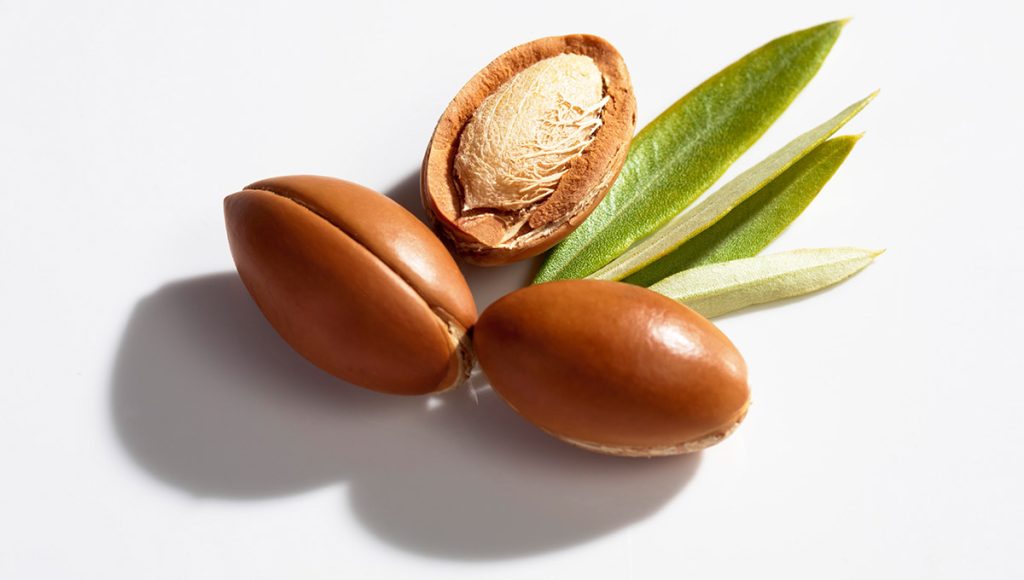
Let’s be real—if you’re still side-eyeing oils, totally fair. But let me put your mind to ease with one oil in particular: argan oil. It’s one of the few that consistently hits that sweet spot—non-comedogenic, absorbent, and so ridiculously nourishing.
Argan Oil is Non-Comedogenic
Argan oil gets a comedogenic rating of 0 to 1.
Yes, ZERO to ONE. That’s skincare gold 🔥
Here’s why it’s a go-to for glow without breakouts:
- Lightweight with high antioxidant content
- Non-clogging and doesn’t sit heavily on skin
- Contains Vitamin E + essential fatty acids
- Supports elasticity and tones uneven complexion
Which makes the Nasola Kojic Acid Argan Skincare Bio Oil a solid choice no matter your age or skin history. If you want glow without grease? BABY, this is it.
Ideal for Sensitive and Aging Skin
Argan is excellent for mature or easily-irritated skin because:
- It simulates sebum levels naturally without throwing off your skin cycle
- Reinforces barrier function especially during seasonal shifts
- Rescues skin post-facial or chemical exfoliation 🧖🏻♀️
- Boosts firmness while softening fine lines
You could be 25 or 65—it adapts.
Why the Base Formula Matters More Than the Term “Bio Oil”

Here’s what’s WILD. People hear “Bio Oil” and assume one-size-fits-all.
Nope. The phrase “bio oil” isn’t even a regulated product title—it can refer to dozens of oil blends. The real magic (or mishap) lies in what oils get top billing.
Carrier Oils vs. Essential Oils
Carrier oils = the foundation. If the base oil is comedogenic, nothing else matters. But with low-comedogenic oils (like in Nasola), you get the benefits of botanical extracts + actives without the weight. Carrier oils also determine absorption rates.
Choose oils with:
- Zero to 2 comedogenic rating
- Natural antioxidants
- Compatible textures for your skin type
- No synthetics or fillers
Prioritize safety AND results.
Lightweight Oils and Rapid Absorption
Light oils = happy skin. They penetrate versus sitting on top. That’s why Nasola Bio Oils never feel greasy—they’re built for efficacy and elegance.
What to love:
- Smooth finish that preps skin for SPF or makeup
- Non-acnegenic and breathable
- Absorbs in seconds, not minutes…
- Skin feels restored immediately, not clogged or coated
How to Choose the Best Bio Oil for Your Skin Concerns

Every skin concern calls for a different kind of support.
The good news?
You don’t need a skincare closet that looks like Sephora. Just the right Bio Oil formula tailored to your goals.
Customize Based on Your Skin Goals
- Hyperpigmentation: Kojic Acid + Turmeric = Fade city.
- Acne-prone: Kojic Acid + Tea Tree + Salicylic = Clearer tomorrow.
- Anti-Aging & Dry Skin: Kojic Acid + Argan = Refreshed and renewed.
These power combos bring results:
- Minimized breakouts
- Better texture & faster skin turnover
- Hydration that lasts 12+ hours
- Dark spots visibly lighter in weeks
Layering with Other Products
Some quick Do’s and Don’ts:
- Use post-cleansing, before cream or sunscreen
- No need to “layer heavy”—a little goes a long way
- Avoid combining Bio Oil with AHA/BHA on the same day unless your skin is veteran-level 💪🏼
- Allow full absorption (~30 seconds) before your next step
Oil doesn’t trap bacteria. It seals in moisture when used right.
Conclusion
So—does Bio Oil clog pores? It totally depends on the formula. Traditional versions might, but modern skincare heroes like Nasola’s Kojic Acid Bio Oils are designed to do exactly the opposite.
With low-comedogenic bases and powerhouse extras like turmeric, tea tree, salicylic acid, and kojic acid, your skin gets the full feast WITHOUT the breakout side effect. Real results with real comfort.
Want smooth, even-toned skin minus the drama?
Shop Nasola’s targeted Bio Oils and finally trust what you’re putting on your face 💛
Frequently Asked Questions (FAQs)
Bio Oil’s original formula may clog pores due to heavier oils like mineral oil. However, modern blends like Nasola’s Kojic Acid Bio Oils are non-comedogenic, using ingredients like argan and turmeric to avoid pore blockage while delivering hydration and brightening.
Yes—if you’re choosing the right formulation. Nasola’s Kojic Acid Tea Tree Bio Oil includes both salicylic acid and tea tree oil, which help prevent breakouts while soothing inflammation. Skip the original and go targeted.
Nasola’s Kojic Acid Turmeric Bio Oil is specially formulated for brightening dark spots and uneven skin tone. Kojic acid reduces melanin production while turmeric calms irritation.
Only if it contains strong fragrances or heavy oils. Nasola’s Kojic Acid Argan Bio Oil is ideal for sensitive skin because it hydrates deeply without synthetic irritants.
Yes, but apply Bio Oil after using retinol or vitamin C serums to seal in moisture and buffer skin sensitivity. Nasola’s fast-absorbing oils won’t interfere with active ingredients.
Once or twice daily depending on your skin’s needs. For oily skin, start with once daily at night. For dry skin, you may benefit from both AM and PM use.
Look for oils of comedogenic rating 0–1 like argan oil, tea tree oil, and lightweight carriers. Nasola oils only use non-blocking base oils so your pores stay clean.
Yes, especially when it includes kojic acid and anti-inflammatory agents. Nasola’s Kojic Acid Bio Oils hydrate the skin while fading discoloration left behind from breakouts.
Try Nasola Kojic Acid Tea Tree Skincare Bio Oil with Salicylic Acid. It balances oiliness in the T-zone while moisturizing dry areas and fading spots.
Absolutely. A formula like Nasola’s Kojic Acid Argan Bio Oil offers anti-aging benefits such as elasticity support, antioxidant protection, and hydration—all without clogging pores.

